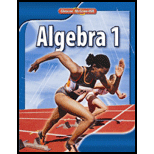
Concept explainers
(a)
A table to show the bacteria population for the first 4 hours
(a)
Answer to Problem 29PPS
| Time(hours) t | Bacteria |
| 0 | 12 |
| 1 | 36 |
| 2 | 108 |
| 3 | 324 |
| 4 | 972 |
Explanation of Solution
Given:
A scientiost estimates that a bacteria culture with an initial population of 12 will triple every hours.
Concept Used:
Rules of Addition/ Subtraction:
- Two numbers with similar sign always get added and the resulting number will carry the similar sign.
- Two numbers with opposite signs always get subtracted and the resulting number will carry the sign of larger number.
Calculation:
In order to make a table of bacteria population
| Time(hours) t | Bacteria |
| 0 | 12 |
| 1 | 36 |
| 2 | 108 |
| 3 | 324 |
| 4 | 972 |
Thus, the table is above for the population of bacteria every hour
(b)
Which kind of model best represents the data
(b)
Answer to Problem 29PPS
The model is exponential
Explanation of Solution
Given: the table
| Time(hours) t | Bacteria |
| 0 | 12 |
| 1 | 36 |
| 2 | 108 |
| 3 | 324 |
| 4 | 972 |
Concept Used:
If first difference of y-values is equal, then model be linear
If second difference be equal, then the model be quadratic
If first and second differences are not equal then the model will be exponential
Calculation:
In order to the models we see that in the table there is a constant ratio of 3 and the best models is a exponential function of the form
(c)
The function that models the data
(c)
Answer to Problem 29PPS
The function is
Explanation of Solution
Calculation:
In order to find the function we have constant ratio is 3 so
Thus, the function is
(d)
How many bacteria after 8 hours
(d)
Answer to Problem 29PPS
The number of bacteria after 8 hours is
Explanation of Solution
Calculation:
In order to find the number of bacteria after 8 hours shown below:
Thus, the number of bacteria after 8 hours is
Chapter 9 Solutions
Algebra 1
Additional Math Textbook Solutions
University Calculus: Early Transcendentals (4th Edition)
Algebra and Trigonometry (6th Edition)
Pre-Algebra Student Edition
Thinking Mathematically (6th Edition)
Basic Business Statistics, Student Value Edition
Elementary Statistics: Picturing the World (7th Edition)
- > > > we are hiring Salesforce Admin Location: Remote Key Responsibilities: Administer Salesforce Sales & Revenue Cloud (CPQ & Billing) Configure workflows, validation rules & dashboards Automate processes using Flows & Process Builder Collaborate with Sales, Finance & Marketing teams Manage user roles & security Apply: Hr@forcecraver.comarrow_forwardAnswer this questionarrow_forward1. vector projection. Assume, ER1001 and you know the following: ||||=4, 7=-0.5.7. For each of the following, explicitly compute the value. འབ (a) (b) (c) (d) answer. Explicitly compute ||y7||. Explain your answer. Explicitly compute the cosine similarity of and y. Explain your Explicitly compute (x, y). Explain your answer. Find the projection of onto y and the projection of onto .arrow_forward
- 2. Answer the following questions using vectors u and v. --0-0-0 = find the the cosine similarity and the angle between u and v. འརྒྱ (a) (b) find the scalar projection of u onto v. (c) find the projection of u onto v. (d) (e) (f) find the scalar projection of onto u. find the projection of u onto u. find the projection of u onto and the projection of onto . (Hint: find the inner product and verify the orthogonality)arrow_forwardPlease type out answerarrow_forwardPlease type out answerarrow_forward
- Please type out answerarrow_forwardUsing f(x) = log x, what is the x-intercept of g(x) = log (x + 4)? Explain your reasoning. Please type out answerarrow_forwardThe function f(x) = log x is transformed to produce g(x) = log (x) – 3. Identify the type of transformation and describe the change. Please type out answerarrow_forward
- Each graph below is the graph of a system of three linear equations in three unknowns of the form Ax = b. Determine whether each system has a solution and, if it does, the number of free variables. A. O free variables ✓ B. no solution C. no solution D. no solution E. 1 free variable F. 1 free variablearrow_forwardSolve the following systems of equations and show all work.y = x2 + 3y = x + 5 Please type out answerarrow_forwardSolve the following system of equations. Show all work and solutions.y = 2x2 + 6x + 1y = −4x2 + 1 Please type out answerarrow_forward
 Algebra and Trigonometry (6th Edition)AlgebraISBN:9780134463216Author:Robert F. BlitzerPublisher:PEARSON
Algebra and Trigonometry (6th Edition)AlgebraISBN:9780134463216Author:Robert F. BlitzerPublisher:PEARSON Contemporary Abstract AlgebraAlgebraISBN:9781305657960Author:Joseph GallianPublisher:Cengage Learning
Contemporary Abstract AlgebraAlgebraISBN:9781305657960Author:Joseph GallianPublisher:Cengage Learning Linear Algebra: A Modern IntroductionAlgebraISBN:9781285463247Author:David PoolePublisher:Cengage Learning
Linear Algebra: A Modern IntroductionAlgebraISBN:9781285463247Author:David PoolePublisher:Cengage Learning Algebra And Trigonometry (11th Edition)AlgebraISBN:9780135163078Author:Michael SullivanPublisher:PEARSON
Algebra And Trigonometry (11th Edition)AlgebraISBN:9780135163078Author:Michael SullivanPublisher:PEARSON Introduction to Linear Algebra, Fifth EditionAlgebraISBN:9780980232776Author:Gilbert StrangPublisher:Wellesley-Cambridge Press
Introduction to Linear Algebra, Fifth EditionAlgebraISBN:9780980232776Author:Gilbert StrangPublisher:Wellesley-Cambridge Press College Algebra (Collegiate Math)AlgebraISBN:9780077836344Author:Julie Miller, Donna GerkenPublisher:McGraw-Hill Education
College Algebra (Collegiate Math)AlgebraISBN:9780077836344Author:Julie Miller, Donna GerkenPublisher:McGraw-Hill Education





